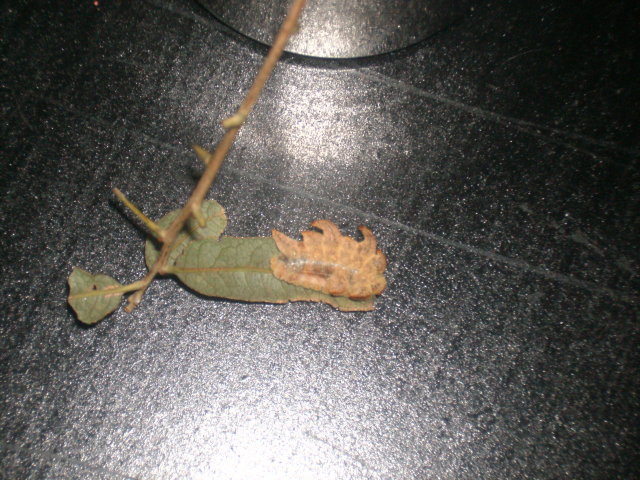Question Sanyo605.jpg
Sanyo605.jpg
QUESTION: I am sending you a photo of some "thing" that is on my daughter's oak tree. Can you tell us what it it??? Susan
ANSWER: This is a hag moth caterpillar. The hag moth larva, sometimes called the monkey slug, is distinctive in form and easy to identify. The full-grown caterpillar is brown, hairy, and about 5/8 inch long. Along the body there are nine pairs of fleshy lateral processes which bear hidden urticating setae. The third, fifth, and seventh pairs of processes are long and sometimes twisted. These have been described as resembling "disheveled locks of a hag", apparently the basis for the common name.
The caterpillar is generally a solitary feeder, and will feed on foliage of several trees including apple, ash, birch, dogwood, hickory, oak, and willow. It has been collected from July into fall, but is usually most common in August and September
The curly "arms" are actually just lobes of hairy flesh atop the caterpillar. If you turn the caterpillar over you'll see the usual legs and head. Those hairs on the "arms" are capable of stinging, so this caterpillar is very well defended.
It will eat the leaves of oak but will not cause any damage except for the stinging hairs.
---------- FOLLOW-UP ----------
QUESTION: Will the stinging hairs hurt a young puppy if she eats the catterpillar? She is at an age where she will chew on almost anything, or at least pick it up. Would children be hurt by the sting? Are most people allergic to it?
AnswerSome people experience severe reactions to the poison released by the spines and require medical attention. Others experience only an itching or burning sensation.
Treatment-Place Scotch tape over the affected area and strip off repeatedly to remove spines. Apply ice packs to reduce the stinging sensation, and follow with a paste of baking soda and water. If the victim has a history of hay fever, asthma or allergy, or if allergic reactions develop, contact a physician immediately.
Diagnosis is usually simple since a rash generally breaks out where the hairs or spines have made skin contact. Immediate application and repeated stripping with adhesive or transparent tape over the sting site may be helpful in removing broken hairs or spines. Washing the affected skin area thoroughly with soap and water may help remove irritating venom. Prompt application of an ice pack and a baking soda poultice should help reduce pain and swelling. Household analgesics, such as aspirin, appear to be ineffective for reducing pain and headache. However, oral administration of antihistamines may help relieve itching and burning. Topical corticosteriods may reduce the intensity of inflammatory reaction. Desoximetasone gel applied twice daily to affected areas will help.
Prompt referral to and treatment by a physician should be made when severe reactions are evident. Some physicians reportedly have successfully treated severe cases with intravenous calcium gluconate codeine and prescription analgesics. Very young, aged or unhealthy persons are more likely to suffer severe reaction symptoms.
I would think a dog might get curious and smell the caterpillar and possibly get a few hairs on its nose but the sting would repel them from "eating" or picking up the moth.






